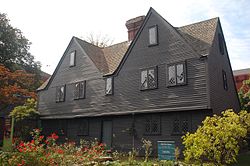John Ward House (Salem, Massachusetts)
|
John Ward House
|
|

John Ward House on Brown Street
|
|
| Location | Salem, Massachusetts |
|---|---|
| Coordinates | 42°31′22″N 70°53′36″W / 42.52278°N 70.89333°WCoordinates: 42°31′22″N 70°53′36″W / 42.52278°N 70.89333°W |
| Built | 1684 |
| Architect | Ward,John |
| Architectural style | First Period |
| Part of |
Essex Institute Historic District (#72000147) Salem Common Historic District (#76000303) |
| NRHP Reference # | |
| Significant dates | |
| Added to NRHP | November 24, 1968 |
| Designated NHL | November 24, 1968 |
| Designated CP | June 22, 1972 May 12, 1976 |
The John Ward House is a National Historic Landmark at 132 Essex Street in Salem, Massachusetts. With an early construction history between 1684 and 1723, it is an excellent example of First Period architecture, and as the subject of an early 20th century restoration by antiquarian George Francis Dow, it is an important example of the restoration techniques. Now owned by the Peabody Essex Museum, it is also one of the first colonial-era houses in the United States to be opened as a museum. It was designated a National Historic Landmark in 1968.
The Ward House was built in three distinct phases. John Ward, a currier by profession, built the first portion of the house in 1684. This consisted of a two story structure with one room on each floor, and a large chimney at one end. This portion was extended by Ward to the right-side of the chimney, giving the house a typical colonial five-bay facade, with center entry and chimney. The last addition to the house was the leanto at the rear, which gave the house a saltbox appearance, and was apparently added not long before Ward's death in 1734. By this time he was apparently sharing the house with his son Benjamin, who inherited the property. The house remained in the hands of the Ward family until 1816, when it was sold at auction as part of an estate.
The buyer at auction was Temple Hardy, who lived in the house for forty years, and operated a bakery on the premises. The house was then converted to a multi-unit residential tenement, which it remained until 1910. At some point in the 19th century a wing was added to the east end of the building; this was removed before 1905. Originally located on Prison Lane (now St. Peter Street), the house was moved to its present site in 1910 by splitting it into two and rolling it on ox-drawn logs from its original site three blocks away. In 1912 the house underwent a careful restoration under the direction of antiquarian George Francis Dow. Dow's work included decorating the space to meet his conception of the use of the house c. 1700. In 1911, parts of the house were opened to the public, becoming the first outdoor museum of architecture in the country. The Peabody Essex Museum now offers guided tours of the house. Rooms on the first floor feature 17th century furnishings and displays in the leanto on retail premises of the period.
...
Wikipedia


